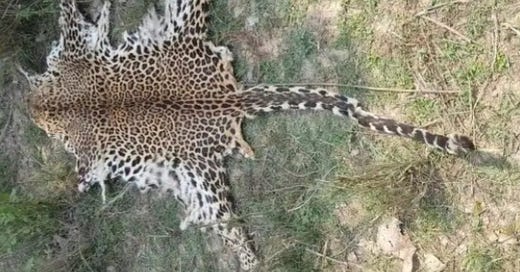Shadows of greed threatening tigers, lions, jaguars, leopards and snow leopards
Diving deeper into wildlife crime...
For the purpose of this short essay I’ve added snow leopards to the big cats, the threat to the mountain ghost the same as it is to the leopard of which another one has succumbed to man as seen in this skin seized in Odisha two days ago - one of hundreds of leopards killed every year in South Asia. In previous writing I've touched on the care factor, or maybe I should write the lack of it. Tomorrow in an email to Patrons I'll go further into our own efforts to combat this deadly issue. Today, a bit more of the nitty gritty, we need people to understand, shake the apathy which is killing big cats.
The world's most charismatic predators – tigers, lions, jaguars, leopards, and snow leopards – stand as potent symbols of wildness and ecological balance. Yet, a sinister force casts a long shadow over their existence: wildlife crime. Driven by greed and fueled by demand for their body parts and live specimens, this illicit trade relentlessly decimates populations, pushing these iconic species closer to the brink of extinction. The multifaceted problems stemming from this criminal activity are complex and far-reaching, demanding urgent and concerted global action.
One of the most significant threats is poaching, often driven by the lucrative black market for their bones, skins, teeth, claws, and other body parts. In traditional medicine, particularly in some parts of Asia, tiger bones are erroneously believed to possess medicinal properties, fueling a persistent demand that has decimated wild tiger populations. Similarly, lion bones are increasingly being used as a substitute, placing further pressure on African lion populations already facing habitat loss and human-wildlife conflict. The allure of exotic skins for fashion and decorative purposes also drives the illegal hunting of leopards and jaguars, leaving fragmented and vulnerable populations in their wake. I've written before how leopard bones are also high on a complicated criminal agenda, in Blood of the Leopard I'm going as deep as possible as to why this is happening, there's a trend now that big cat bones are the primary objective for traffickers, moreso than skins.
Even the elusive snow leopard, dwelling in remote high-altitude regions, is not immune, falling victim to poachers seeking their luxurious fur as well as their bones. Retaliation against snow leopards killing livestock, as is the case with the four other great cat species, can mean a supply of body parts hard to cut off in the world's highest mountains.
The sophistication of poaching techniques, ranging from snares and poisoned baits to organized hunting expeditions, further exacerbates the challenge of effective law enforcement. Where that effectiveness is in jeopardy anyway because of lack of motivation and resources, great cats die brutal deaths.
Beyond poaching for body parts, the illegal trade in live animals poses another grave threat. Cubs and kittens of these big cat species are snatched from the wild to supply the exotic pet trade or poorly regulated zoos and circuses. This cruel practice not only reduces wild populations but also inflicts immense suffering on the animals, with high mortality rates during capture and transportation. Furthermore, these captive animals often face inadequate living conditions and lack the opportunity to express their natural behaviors, contributing nothing to conservation efforts.
The consequences of wildlife crime extend far beyond the direct loss of individual animals. The disruption of ecosystems is a critical concern. As apex predators, these big cats play a vital role in regulating prey populations, maintaining the health and balance of their habitats. Their removal can trigger trophic cascades, leading to overgrazing by herbivores, habitat degradation, and a decline in biodiversity. For instance, the disappearance of leopards in local extinction circumstances can have cascading effects on the populations of their prey and the overall structure of the forest.
Wildlife crime often has strong links to organized crime networks, involving corruption, money laundering, and even violence. These well-funded and sophisticated criminal enterprises operate across borders, making detection and prosecution incredibly challenging. The involvement of such networks not only fuels the illegal trade but also undermines governance and the rule of law in the regions where these crimes occur.
Addressing the problems of wildlife crime affecting big cats requires a multi-pronged approach. Strengthening law enforcement at local, national, and international levels is paramount. This includes increasing patrols in protected areas, improving detection technologies (more about our efforts in this regard in the Patron's email tomorrow), enhancing cross-border collaboration, and ensuring that perpetrators face meaningful penalties. Reducing demand through public awareness campaigns and addressing the underlying cultural beliefs that drive the consumption of big cat products is equally crucial. Engaging local communities in conservation efforts, providing them with sustainable livelihood alternatives, and fostering a sense of ownership over wildlife can also be highly effective in combating poaching.
Ultimately, the survival of tigers, lions, jaguars, leopards, and snow leopards hinges on our collective ability to dismantle the criminal networks that threaten them. Wildlife crime is not just an environmental issue; it is a complex problem with economic, social, and ethical dimensions. Only through a concerted global effort, driven by strong political will, effective law enforcement, and a fundamental shift in human attitudes towards wildlife, can we hope to secure a future where these magnificent creatures roam free in their natural habitats, unburdened by the shadows of greed.
This overview has been for people who needed to know more, you can also go to wildtiger.org (and please consider becoming a Patron) as we expand information but my great hope is that this essay touches your duty of care.
Care must be in the form of action, the magnificent species I've written about today depend on that.




